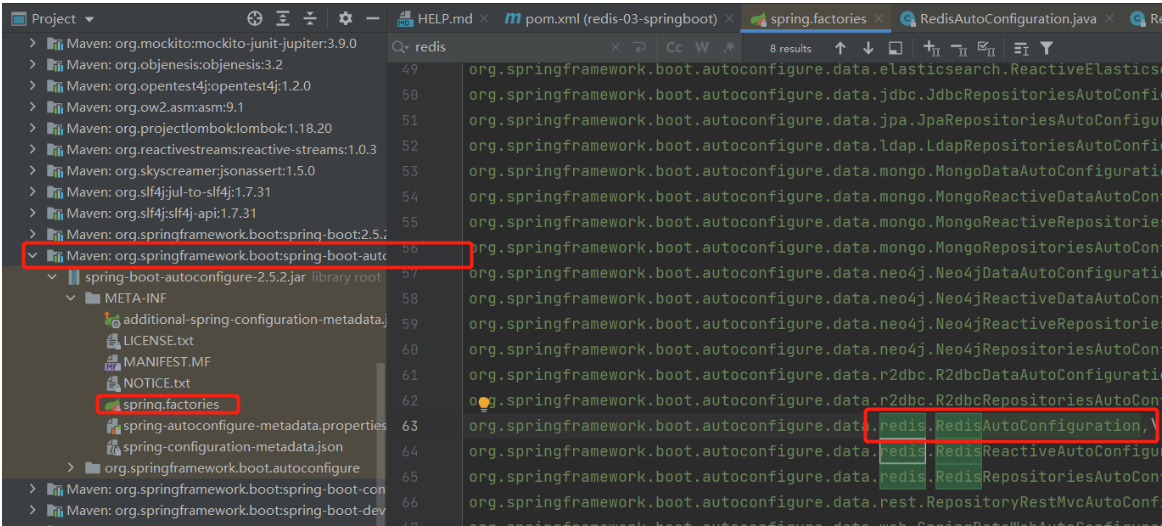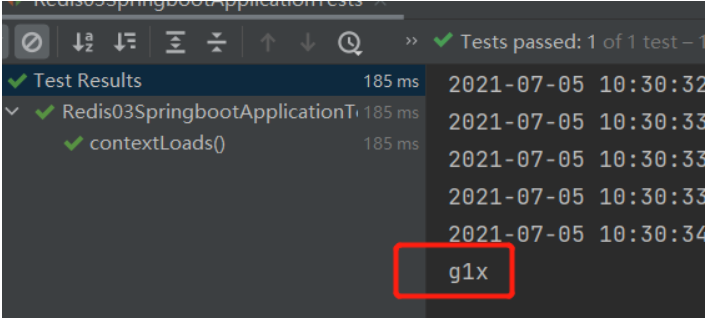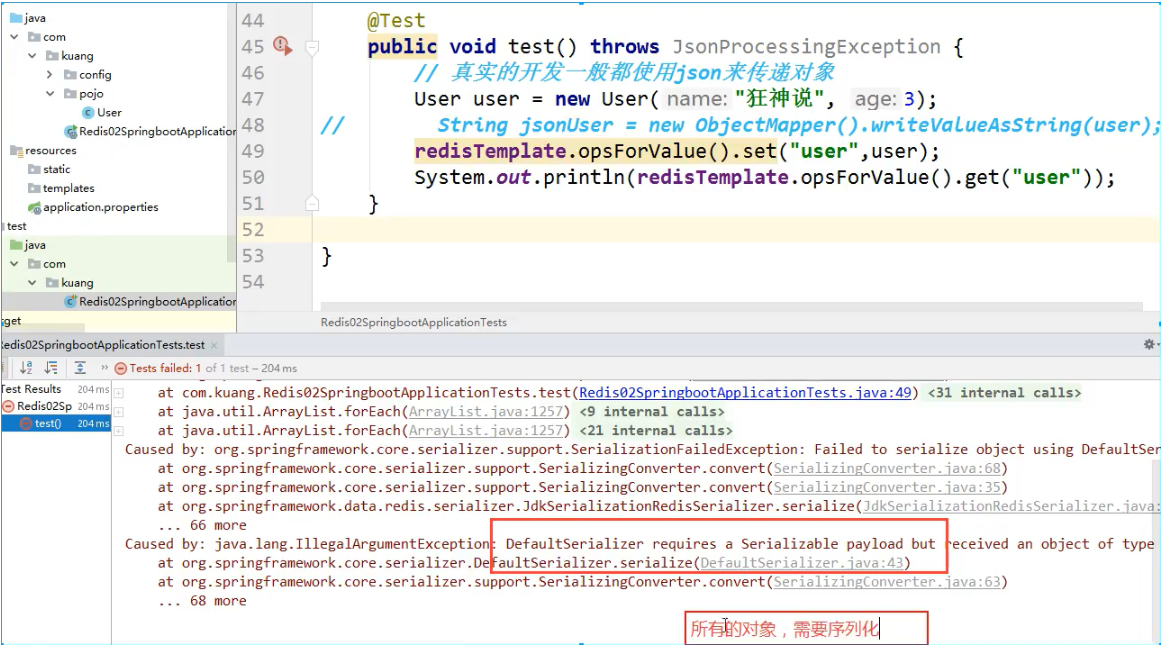这篇文章主要介绍了SpringBoot整合Redis案例分析的相关知识,内容详细易懂,操作简单快捷,具有一定借鉴价值,相信大家阅读完这篇springBoot整合Redis案例分析文章都会有所收获,下面我们一起来看看吧。Springboot整
这篇文章主要介绍了SpringBoot整合Redis案例分析的相关知识,内容详细易懂,操作简单快捷,具有一定借鉴价值,相信大家阅读完这篇springBoot整合Redis案例分析文章都会有所收获,下面我们一起来看看吧。
下载路径cmd,然后redis-server.exe redis.windows.conf命令既可以启动服
在redis目录下点击redis-cli.exe进行测试结果查看,基本操作如下
key * :查看存储内容
flushdb :清空数据库
undefined
SpringData也是和SpringBoot齐名的项目!
说明:在SpringBoot2.x之后,原来使用的jedis被替换为了lettuce
jedis:采用的直连,多个线程操作的话,是不安全的,如果想要避免不安全的,使用jedis pool连接池!【类似于Bio:同步阻塞IO】
lettuce:采用Netty【异步请求,性能更高点】,实例可以再多个线程中进行共享,不存在线程不安全的情况!可以减少线程数量了【类似于NIO:同步非阻塞IO】
异步请求一般都需要序列化
源码分析:
源码位置:
@Bean//当这个Bean不存在的时候,这个类就生效//这就说明,我们可以自己定义一个redisTemplate来替换这个默认的!@ConditionalOnMissingBean(name = "redisTemplate")@ConditionalOnSingleCandidate(RedisConnectionFactory.class)public RedisTemplate<Object, Object> redisTemplate(RedisConnectionFactory redisConnectionFactory) { //默认的RedisTemplate没有过多的设置,redis,对象都是需要序列化的! //两个泛型都是Object类型,我们后面使用需要强制转换:我们需要的类型<String, Object>RedisTemplate<Object, Object> template = new RedisTemplate<>();template.setConnectionFactory(redisConnectionFactory);return template;}@Bean@ConditionalOnMissingBean//由于String是Redis最常用的类型,所以说单独提出来了一个Bean@ConditionalOnSingleCandidate(RedisConnectionFactory.class)public StringRedisTemplate stringRedisTemplate(RedisConnectionFactory redisConnectionFactory) {StringRedisTemplate template = new StringRedisTemplate();template.setConnectionFactory(redisConnectionFactory);return template;}<!--操作redis--> <dependency> <groupId>org.springframework.boot</groupId> <artifactId>spring-boot-starter-data-redis</artifactId> </dependency><!--上面redis不兼容时候,可以换成jedis--><dependency> <groupId>org.springframework.boot</groupId> <artifactId>spring-boot-starter-data-redis</artifactId> <exclusions> <exclusion> <groupId>io.lettuce</groupId> <artifactId>lettuce-core</artifactId> </exclusion> </exclusions></dependency><dependency> <groupId>redis.clients</groupId> <artifactId>jedis</artifactId></dependency># SpringBoot所有的配置类,都有一个自动配置类 RedisAutoConfiguration# 自动配置类都会绑定一个properties配置文件 RedisPropertiesspring: redis: host: 127.0.0.1 # Redis服务器连接端口 port: 6379 # Redis数据库索引(默认为0) database: 0 # Redis服务器连接密码(默认为空) passWord: # 连接池最大连接数(使用负值表示没有限制) pool: max-active: 200 # 连接池最大阻塞等待时间(使用负值表示没有限制) max-wait: -1 # 连接池中的最大空闲连接 max-idle: 10 # 连接池中的最小空闲连接 min-idle: 0 # 连接超时时间(毫秒) timeout: 1000@SpringBootTestclass Redis03SpringbootApplicationTests { //注入RedisAutoConfiguration里面配置的类 @Autowired public RedisTemplate redisTemplate; @Test void contextLoads() { //redisTemplate :操作我们的数据库,api和我们的是一样的 //opsForValue :操作字符串 类似String //opsForList :操作List //除了基本的操作,我们常用的方法都可以直接通过redisTemplate进行操作 //比如事务和基本的CRUD //获取redis的连接对象,就可以操作数据库的连接了【一般很少来用】 redisTemplate.opsForValue().set("kami", "g1x"); System.out.println(redisTemplate.opsForValue().get("kami")); }}
keys *会出来乱码
这是默认的序列化配置

默认序列化方式是jdk序列化

自己写了后,原来默认的RedisTemplate就会失效
创建一个config
@Configurationpublic class RedisConfig { //编写我们自己的RedisTemplate @Bean public RedisTemplate<String, Object> redisTemplate(RedisConnectionFactory redisConnectionFactory) { RedisTemplate<String, Object> template = new RedisTemplate<>(); //这里面到底怎么配置看后面 template.setConnectionFactory(redisConnectionFactory); return template; }}//将它变为组件,方便调用@Component@Data@AllArgsConstructor@NoArgsConstructorpublic class User { private String name; private Integer age;} @Test public void test() throws jsonProcessingException { //真实开发中一般都使用json来传递对象,所以要序列化json User user = new User("葛", 3); //所以要序列化成json对象【变成了json字符串】 String jsonUser = new ObjectMapper().writeValueAsString(user); redisTemplate.opsForValue().set("user", jsonUser); System.out.println(redisTemplate.opsForValue().get("user")); }如果不用上面的序列化json对象操作会报错!String jsonUser = new ObjectMapper().writeValueAsString(user);
下面是关于对象的保存,但是一般都是用json对象

//将它变为组件,方便调用@Component@Data@AllArgsConstructor@NoArgsConstructorpublic class User implements Serializable { private String name; private Integer age;}创建一个config

//这里面到底怎么配置看后面Jackson2JsonRedisSerializer<Object> objectJackson2JsonRedisSerializer = new Jackson2JsonRedisSerializer<Object>();//配置具体的序列化template.seTKEySerializer(objectJackson2JsonRedisSerializer);多种序列化方式
写法例子
自己写很费劲,用已经写好的例子即可
连接中有不同地方,复制连接中import com.fasterxml.jackson.annotation.JsonAutoDetect;import com.fasterxml.jackson.annotation.PropertyAccessor;import com.fasterxml.jackson.databind.ObjectMapper;import org.springframework.context.annotation.Bean;import org.springframework.context.annotation.Configuration;import org.springframework.data.redis.connection.RedisConnectionFactory;import org.springframework.data.redis.core.RedisTemplate;import org.springframework.data.redis.serializer.Jackson2JsonRedisSerializer;import org.springframework.data.redis.serializer.StringRedisSerializer; import java.rmi.UnknownHostException; @Configurationpublic class RedisConfig { @Bean @SuppressWarnings("all") public RedisTemplate<String, Object> redisTemplate(RedisConnectionFactory redisConnectionFactory) throws UnknownHostException { // 自定义 String Object RedisTemplate<String, Object> template = new RedisTemplate(); template.setConnectionFactory(redisConnectionFactory); // Json 序列化配置 Jackson2JsonRedisSerializer<Object> objectJackson2JsonRedisSerializer = new Jackson2JsonRedisSerializer<Object>(Object.class); // ObjectMapper 转译 ObjectMapper objectMapper = new ObjectMapper(); objectMapper.setVisibility(PropertyAccessor.ALL, JsonAutoDetect.Visibility.ANY); objectMapper.enableDefaultTyping(ObjectMapper.DefaultTyping.NON_FINAL); objectJackson2JsonRedisSerializer.setObjectMapper(objectMapper); // String 的序列化 StringRedisSerializer stringRedisSerializer = new StringRedisSerializer(); // key 采用String的序列化方式 template.setKeySerializer(stringRedisSerializer); // hash 的key也采用 String 的序列化方式 template.setHashKeySerializer(stringRedisSerializer); // value 序列化方式采用 jackson template.setValueSerializer(objectJackson2JsonRedisSerializer); // hash 的 value 采用 jackson template.setHashValueSerializer(objectJackson2JsonRedisSerializer); template.afterPropertiesSet(); return template; }}编写工具类
package com.kami.utils;import org.springframework.beans.factory.annotation.Autowired;import org.springframework.data.redis.core.RedisTemplate;import org.springframework.stereotype.Component;import org.springframework.util.CollectionUtils;import java.util.List;import java.util.Map;import java.util.Set;import java.util.concurrent.TimeUnit;@Componentpublic final class RedisUtil { @Autowired private RedisTemplate<String, Object> redisTemplate; public boolean expire(String key, long time) { try { if (time > 0) { redisTemplate.expire(key, time, TimeUnit.SECONDS); } return true; } catch (Exception e) { e.printStackTrace(); return false; } } public long getExpire(String key) { return redisTemplate.getExpire(key, TimeUnit.SECONDS); } public boolean hashKey(String key) { try { return redisTemplate.hasKey(key); } catch (Exception e) { e.printStackTrace(); return false; } } public void del(String... key) { if (key != null && key.length > 0) { redisTemplate.delete(key[0]); } else { redisTemplate.delete(CollectionUtils.arrayToList(key)); } } //==================================String==================================== public Object get(String key) { return key == null ? null : redisTemplate.opsForValue().get(key); } public boolean set(String key, Object value) { try { redisTemplate.opsForValue().set(key, value); return true; } catch (Exception e) { e.printStackTrace(); return false; } } public boolean set(String key, Object value, long time) { try { if (time > 0) { redisTemplate.opsForValue().set(key, value, time, TimeUnit.SECONDS); } else { set(key, value); } return true; } catch (Exception e) { e.printStackTrace(); return false; } } public long incr(String key, long delta) { if (delta < 0) { throw new RuntimeException("递增因子必须大于0"); } return redisTemplate.opsForValue().increment(key, delta); } public long decr(String key, long delta) { if (delta < 0) { throw new RuntimeException("递减因子必须大于0"); } return redisTemplate.opsForValue().decrement(key, delta); } // ================================Map================================= public Object hget(String key, String item) { return redisTemplate.opsForHash().get(key, item); } public Map<Object, Object> hmget(String key) { return redisTemplate.opsForHash().entries(key); } public boolean hmset(String key, Map<String, Object> map) { try { redisTemplate.opsForHash().putAll(key, map); return true; } catch (Exception e) { e.printStackTrace(); return false; } } public boolean hmset(String key, Map<String, Object> map, long time) { try { redisTemplate.opsForHash().putAll(key, map); if (time > 0) { expire(key, time); } return true; } catch (Exception e) { e.printStackTrace(); return false; } } public boolean hset(String key, String item, Object value) { try { redisTemplate.opsForHash().put(key, item, value); return true; } catch (Exception e) { e.printStackTrace(); return false; } } public boolean hset(String key, String item, Object value, long time) { try { redisTemplate.opsForHash().put(key, item, value); if (time > 0) { expire(key, time); } return true; } catch (Exception e) { e.printStackTrace(); return false; } } public void hdel(String key, Object... item) { redisTemplate.opsForHash().delete(key, item); } public boolean hHasKey(String key, String item) { return redisTemplate.opsForHash().hasKey(key, item); } public double hincr(String key, String item, double by) { return redisTemplate.opsForHash().increment(key, item, by); } public double hdecr(String key, String item, double by) { return redisTemplate.opsForHash().increment(key, item, -by); } // ============================set============================= public Set<Object> sGet(String key) { try { return redisTemplate.opsForSet().members(key); } catch (Exception e) { e.printStackTrace(); return null; } } public boolean sHasKey(String key, Object value) { try { return redisTemplate.opsForSet().isMember(key, value); } catch (Exception e) { e.printStackTrace(); return false; } } public long sSet(String key, Object... values) { try { return redisTemplate.opsForSet().add(key, values); } catch (Exception e) { e.printStackTrace(); return 0; } } public long sSetAndTime(String key, long time, Object... values) { try { Long count = redisTemplate.opsForSet().add(key, values); if (time > 0) { expire(key, time); } return count; } catch (Exception e) { e.printStackTrace(); return 0; } } public long sGetSetSize(String key) { try { return redisTemplate.opsForSet().size(key); } catch (Exception e) { e.printStackTrace(); return 0; } } public long setRemove(String key, Object... values) { try { Long count = redisTemplate.opsForSet().remove(key, values); return count; } catch (Exception e) { e.printStackTrace(); return 0; } } // ===============================list================================= public List<Object> lGet(String key, long start, long end) { try { return redisTemplate.opsForList().range(key, start, end); } catch (Exception e) { e.printStackTrace(); return null; } } public long lGetListSize(String key) { try { return redisTemplate.opsForList().size(key); } catch (Exception e) { e.printStackTrace(); return 0; } } public Object lGetIndex(String key, long index) { try { return redisTemplate.opsForList().index(key, index); } catch (Exception e) { e.printStackTrace(); return null; } } public boolean lSet(String key, Object value) { try { redisTemplate.opsForList().rightPush(key, value); return true; } catch (Exception e) { e.printStackTrace(); return false; } } public boolean lSet(String key, Object value, long time) { try { redisTemplate.opsForList().rightPush(key, value); if (time > 0) { expire(key, time); } return true; } catch (Exception e) { e.printStackTrace(); return false; } } public boolean lSet(String key, List<Object> value) { try { redisTemplate.opsForList().rightPushAll(key, value); return true; } catch (Exception e) { e.printStackTrace(); return false; } } public boolean lSet(String key, List<Object> value, long time) { try { redisTemplate.opsForList().rightPushAll(key, value); if (time > 0) { expire(key, time); } return true; } catch (Exception e) { e.printStackTrace(); return false; } } public boolean lUpdateIndex(String key, long index, Object value) { try { redisTemplate.opsForList().set(key, index, value); return true; } catch (Exception e) { e.printStackTrace(); return false; } } public long lRemove(String key, long count, Object value) { try { Long remove = redisTemplate.opsForList().remove(key, count, value); return remove; } catch (Exception e) { e.printStackTrace(); return 0; } } // ===============================HyperLogLog================================= public long pfadd(String key, String value) { return redisTemplate.opsForHyperLogLog().add(key, value); } public long pfcount(String key) { return redisTemplate.opsForHyperLogLog().size(key); } public void pfremove(String key) { redisTemplate.opsForHyperLogLog().delete(key); } public void pfmerge(String key1, String key2) { redisTemplate.opsForHyperLogLog().union(key1, key2); }}我们真实的分发中,或者在你们的公司,一般都可以看到一个公司自己封装RedisUtil
转到测试类
@SpringBootTestclass Redis02SpringbootApplicationTests { @Autowired // 指定我们自己定义的redis序列化配置 private RedisTemplate<String, Object> redisTemplate; @Autowired private RedisUtil redisUtil; @Test void test1() { // 清空数据库 redisTemplate.getConnectionFactory().getConnection().flushDb(); User user = new User("zhangsha", 23); redisUtil.set("user", user); System.out.println(redisUtil.get("user")); }}这时候注入的RedisTemplate需要导入的是我们的
结果就是输出前加了转译【不再是乱码】
redis目录中的redis-cle.exe
执行结果

关于“SpringBoot整合Redis案例分析”这篇文章的内容就介绍到这里,感谢各位的阅读!相信大家对“SpringBoot整合Redis案例分析”知识都有一定的了解,大家如果还想学习更多知识,欢迎关注编程网精选频道。
--结束END--
本文标题: SpringBoot整合Redis案例分析
本文链接: https://www.lsjlt.com/news/295845.html(转载时请注明来源链接)
有问题或投稿请发送至: 邮箱/279061341@qq.com QQ/279061341
下载Word文档到电脑,方便收藏和打印~
2024-05-11
2024-05-11
2024-05-11
2024-05-11
2024-05-11
2024-05-11
2024-05-11
2024-05-11
2024-05-11
2024-05-11
回答
回答
回答
回答
回答
回答
回答
回答
回答
回答
0